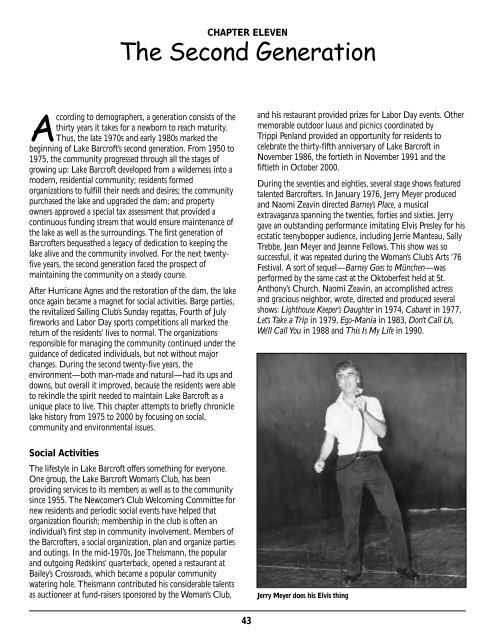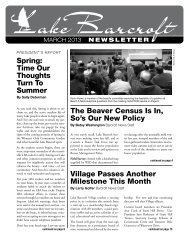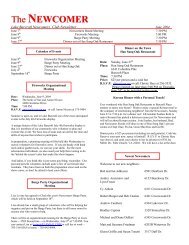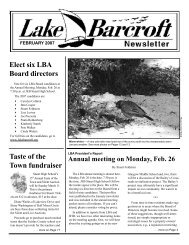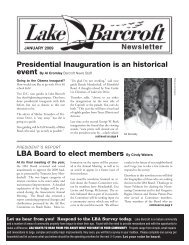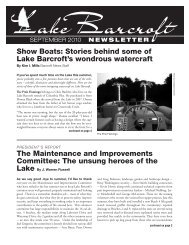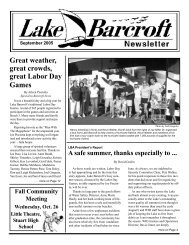Lake Barcroft History Book
Lake Barcroft History Book
Lake Barcroft History Book
You also want an ePaper? Increase the reach of your titles
YUMPU automatically turns print PDFs into web optimized ePapers that Google loves.
According to demographers, a generation consists of the<br />
thirty years it takes for a newborn to reach maturity.<br />
Thus, the late 1970s and early 1980s marked the<br />
beginning of <strong>Lake</strong> <strong>Barcroft</strong>’s second generation. From 1950 to<br />
1975, the community progressed through all the stages of<br />
growing up: <strong>Lake</strong> <strong>Barcroft</strong> developed from a wilderness into a<br />
modern, residential community; residents formed<br />
organizations to fulfill their needs and desires; the community<br />
purchased the lake and upgraded the dam; and property<br />
owners approved a special tax assessment that provided a<br />
continuous funding stream that would ensure maintenance of<br />
the lake as well as the surroundings. The first generation of<br />
<strong>Barcroft</strong>ers bequeathed a legacy of dedication to keeping the<br />
lake alive and the community involved. For the next twentyfive<br />
years, the second generation faced the prospect of<br />
maintaining the community on a steady course.<br />
After Hurricane Agnes and the restoration of the dam, the lake<br />
once again became a magnet for social activities. Barge parties,<br />
the revitalized Sailing Club’s Sunday regattas, Fourth of July<br />
fireworks and Labor Day sports competitions all marked the<br />
return of the residents’ lives to normal. The organizations<br />
responsible for managing the community continued under the<br />
guidance of dedicated individuals, but not without major<br />
changes. During the second twenty-five years, the<br />
environment—both man-made and natural—had its ups and<br />
downs, but overall it improved, because the residents were able<br />
to rekindle the spirit needed to maintain <strong>Lake</strong> <strong>Barcroft</strong> as a<br />
unique place to live. This chapter attempts to briefly chronicle<br />
lake history from 1975 to 2000 by focusing on social,<br />
community and environmental issues.<br />
Social Activities<br />
CHAPTER ELEVEN<br />
The Second Generation<br />
The lifestyle in <strong>Lake</strong> <strong>Barcroft</strong> offers something for everyone.<br />
One group, the <strong>Lake</strong> <strong>Barcroft</strong> Woman’s Club, has been<br />
providing services to its members as well as to the community<br />
since 1955. The Newcomer’s Club Welcoming Committee for<br />
new residents and periodic social events have helped that<br />
organization flourish; membership in the club is often an<br />
individual’s first step in community involvement. Members of<br />
the <strong>Barcroft</strong>ers, a social organization, plan and organize parties<br />
and outings. In the mid-1970s, Joe Theismann, the popular<br />
and outgoing Redskins’ quarterback, opened a restaurant at<br />
Bailey’s Crossroads, which became a popular community<br />
watering hole. Theismann contributed his considerable talents<br />
as auctioneer at fund-raisers sponsored by the Woman’s Club,<br />
43<br />
and his restaurant provided prizes for Labor Day events. Other<br />
memorable outdoor luaus and picnics coordinated by<br />
Trippi Penland provided an opportunity for residents to<br />
celebrate the thirty-fifth anniversary of <strong>Lake</strong> <strong>Barcroft</strong> in<br />
November 1986, the fortieth in November 1991 and the<br />
fiftieth in October 2000.<br />
During the seventies and eighties, several stage shows featured<br />
talented <strong>Barcroft</strong>ers. In January 1976, Jerry Meyer produced<br />
and Naomi Zeavin directed Barney’s Place, a musical<br />
extravaganza spanning the twenties, forties and sixties. Jerry<br />
gave an outstanding performance imitating Elvis Presley for his<br />
ecstatic teenybopper audience, including Jerrie Manteau, Sally<br />
Trebbe, Jean Meyer and Jeanne Fellows. This show was so<br />
successful, it was repeated during the Woman’s Club’s Arts ‘76<br />
Festival. A sort of sequel—Barney Goes to München—was<br />
performed by the same cast at the Oktoberfest held at St.<br />
Anthony’s Church. Naomi Zeavin, an accomplished actress<br />
and gracious neighbor, wrote, directed and produced several<br />
shows: Lighthouse Keeper’s Daughter in 1974, Cabaret in 1977,<br />
Let’s Take a Trip in 1979, Ego-Mania in 1983, Don’t Call Us,<br />
We’ll Call You in 1988 and This Is My Life in 1990.<br />
Jerry Meyer does his Elvis thing


